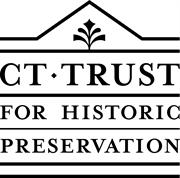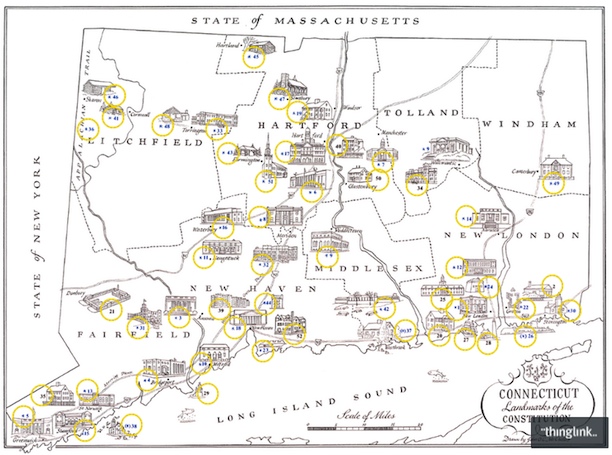THE PREAMBLE
Identifies the Constitution’s Primary Goals. This Map Locates:
- Buildings Constructed to Fulfill Goals Set Forth in the Preamble.
- Buildings Associated with the Defense or Expansion of Constitutional Rights or Freedoms.
- A Building Associated with a Challenge to Federal Powers Established by the Constitution.
IN ORDER TO FORM A MORE PERFECT UNION:
Custom Houses: Under the Constitution, states could no longer charge one another customs duties.
Only the federal government could collect customs on imports from abroad.
- 1. New London: Custom House
- 2. Stonington: Custom House
Post Offices: Early on, communications vital to a “more perfect union” depended heavily on a postal system linking Washington with the states. Elegant post offices built early in this century were familiar local symbols of the federal presence. Their architecture, chosen by Washington, favored classical and early modern styles. Some vacant post offices are threatened with demolition. However, listing on the National Register of Historic Places gives some protection to these federal properties:
- 3. Ansonia: U.S. Post Office
- 4. Bridgeport: U.S. Post Office
- 5. Greenwich: U.S. Post Office
- 6. Hartford: U.S. Post Office
- 7. Manchester: U.S. Post Office
- 8. Meriden: U.S. Post Office
- 9. Middletown: U.S. Post Office
- 10. Milford: U.S. Post Office
- 11. Naugatuck: U.S. Post Office
- 12. New London: U.S. Post Office
- 13. Norwalk: U.S. Post Office
- 14. Norwich: U.S. Post Office
- 15. Stamford: U.S. Post Office
- 16. Waterbury: U.S. Post Office
And the scene of an early challenge to a “more perfect union”
- 17. Hartford: Old State House, NHL
THE HARTFORD CONVENTION during the War of 1812 brought together New England’s leaders to discuss protection against British attacks on coastal towns. Resenting what they thought was President Madison’s neglect of local needs, many delegates opposed the war. The convention’s final report of 1815 gave voice to sentiment for secession and states’ rights.
ESTABLISH JUSTICE , INSURE DOMESTIC TRANQUILITY
Courts: Of 3 US District Courts in Connecticut, 1 is housed in a building of architectural distinction, recently restored:
- 18. New Haven Federal Building (and former Post Office)
Homes of Chief Justices of the United States Supreme Court:
- 19. Windsor: Home of Oliver Ellsworth, Chief Justice 1796-1799
- 20. Old Lyme: Birthplace of Morrison R. Waite, Chief Justice, 1874-1888.
And a Federal Prison:
- 21. Danbury: Federal Correctional Institution
PROVIDE FOR THE COMMON DEFENSE
Forts:
- 22. Groton: Fort Griswold
- 23. New Haven: Fort Nathan Hale
- 24. New London: Fort Trumbull
The Coast Guard Academy:
- 25. New London: Hamilton Hall, United States Coast Guard Academy
Vessels:
- 26. Groton: USS Nautilus, Naval Submarine Base, NHL
- 27. New London: Eagle, United States Coast Guard Academy
Lighthouses: The Coast Guard maintains 18 lighthouses along the state’s coast, including the following especially early ones:
- 28. New London: New London Harbor Light
- 29. Stratford Shoal: Stratford Shoal Light
Several early Lighthouses are now museums, including:
- 30. Stonington: Stonington Harbor Lighthouse
Armories: The President is commander-in-chief of all the Armed Forces, but he delegates to the states responsibility for a National Guard. Connecticut’s Guard has 26 active armories. Among them the following preserve forms modeled on fortresses and favored for armories in the last century and into the 1930s:
- 31. Ansonia: State Armory
- 32. Meriden: State Armory
- 33. Torrington: State Armory
Many armories with towers, turrets, and battlements were scrapped once their original occupants vacated. However, some have been renovated for offices or apartments including the following built for a community militia company:
- 34. Willimantic: Willimantic Armory
|
|
PROMOTE THE GENERAL WELFARE
The National Park Service: The Park Service Administers 61 Miles of Trail In Connecticut, and one historic site in Connecticut, and the state was home to its first director.
- 35. Darien: Stephen Tyng Mather House, NHL
- 36. Northwestern corner of the state: The Appalachian Trail
U.S. Fish and Wildlife Service:
- 37. Westbrook: Murdock Hill Complex
- 38. Norwalk: Sheffield Island Lighthouse
The Veterans Administration:
- 39. West Haven: Veterans Administration Hospital
Home of the First United States Commissioner for Education
- 40. Hartford: Henry Barnard House, NHL
Depression-Era Projects of the Federal Works Progress Administration in Connecticut State Parks: From 1933 to 1942, 30,000 workers in the Civilian Conservation Corps–“Roosevelt’s Tree Army”–built structures for recreation and maintenance in Connecticut state parks. They excelled in log construction, hand-forged iron fittings, and rough masonry work using boulders found on site. Among their work here, The National Register lists:
- 41. Cornwall: Red Mountain Shelter
- 42. East Lyme: Rocky Neck Pavilion
- 43. Farmington: Shade Swamp Shelter
- 44. Hamden: Sleeping Giant Tower
- 45. Hartland: Tunxis Forest Ski Lodge
- 46. Sharon: Cream Hill Shelter
- 47. Simsbury: Massacoe Forest Pavilion
- 48. Torrington: Paugnut Forest Administration Building
AND SECURE THE BLESSINGS OF LIBERTY TO OURSELVES AND OUR POSTERITY
Securing Constitutional rights And freedoms has led to some bitter struggles. Buildings that figured in the ongoing process of bringing the blessings of liberty to groups whose direct mention had been carefully avoided in writing the Constitution include:
- 49. Canterbury: Prudence Crandall House, NHL
- In this house, a school for black girls that opened April, 1, 1833 lasted less than a year in the face of local hostility. However, Prudence Crandall, a white abolitionist, had acted on an irrepressible idea when she opened New England’s first black female academy.
- 50. Glastonbury: Smith Sisters’ House, NHL
- On this their life-long home, Abby and Julia Smith refused to pay real estate taxes in the 1870s, arguing that, as women, they were disenfranchised. Upon inheriting the property they had suffered brazen discrimination by a tax collector. They would not pay what he demanded so he confiscated their prize cows. That made amusing press: wide coverage cited implications of national importance and the incident gained unprecedented sympathy for women’s rights.
“LANDMARK DECISIONS” IN US CONSTITUTIONAL HISTORY
Buildings Associated With Cases That Went To The US Supreme Court And Changed The Interpretation of the Constitution
- 51. Farmington: First Church of Christ, NHL
- THE AMISTAD CASE
- In 1841 the US Supreme Court ruled that captive Africans brought to Connecticut in the ship Amistad were not slaves (legally defined a property), but free men illegally kidnapped. The Farmington congregation cared for these Mendi tribesmen and raised money to return them to Sierra Leone. A landmark victory for abolitionists, the decision upheld the right to rebel against unlawful enslavement, and was challenged in the pre-Civil-War era.
- 52. New Haven: House at 79 Trumbull Street
- GRISWOLD VS CONNECTICUT
- In 1961, by opening a birth control clinic in this house, Planned Parenthood of Connecticut, led by Mrs. Estelle T. Griswold, challenged the state’s archaic obscenity law–the Comstock Law. In 1965 the Supreme Court struck it down, ruling that the law unlawfully invaded the privacy of married couples, Judge Douglas’s majority opinion established a new constitutional right of privacy based on the First, Third, Fourth, Fifth, and Ninth Amendments.
Researched and published by the Connecticut Trust for Historic Preservation
 940 Whitney Avenue, Hamden, CT 06517 940 Whitney Avenue, Hamden, CT 06517
|










